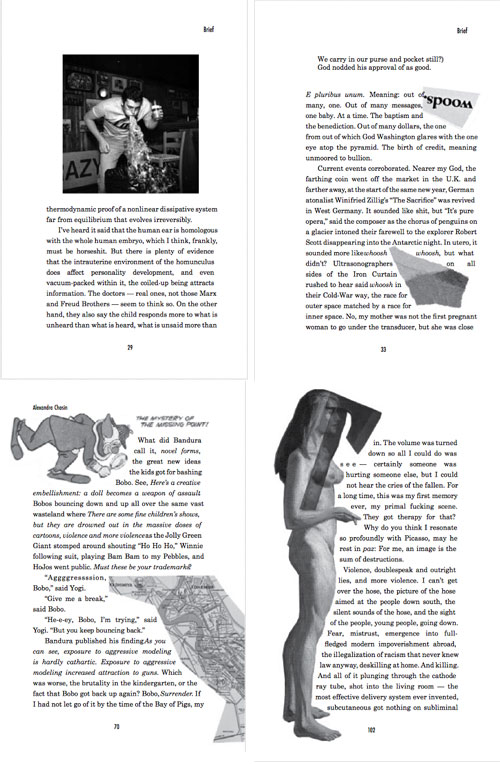A Review of Brief by Alexandra Chasin
 Brief
Brief
by Alexandra Chasin
Jaded Ibis Press, 2012
Paperback: 180 pages / $15 Buy from Jaded Ibis
App Novel / $4.99 Buy from iTunes Store
Just as the pre-digital ancients looked for answers in the stars, coffee grounds, or Sunday astrology columns, today’s mystics look to computer-generated spam, glitch-art, and captchas. With its cold modernist rationalism, literature appears to be a doomed secular medium between these two pseudo-spiritual realms, with books on track to be its tomb.
Neither monkey nor machine, how can The Word survive when challenged by the cybernetic? Alexandra Chasin’s novel/eBook/iPad app Brief is one New Media experiment in literary life-support. Fusing a shizo-analytic modernist screed ala Deleuze and Guattari and Phillip Roth with endless graphic combinations possible via simple computer programming, the work ends-up a high-Modernist mess worthy of gallery exhibition—which might be fine, if such a venue weren’t the protagonist’s target of ire.
In the iPad app version programmed by Scott Peterson, over 34,000,000 images randomly combine and drop into the text. Most of the image-to-text-pairings are misses, doing little to assist the narrative—a 180-page courtroom defense by an art vandal named Inqui (gender indeterminate). Arguing a plea of temporary insanity, Inqui tells the story of their formation from pre-natal to brief stint at art criminal.
It was the Nuclear-Era cultural inundation of violence that drove T.V. Casualty Inqui to scrawl “KILL LIES ALL” on Picasso’s Guernica, an act copy-catting of Tony Shifrazi, who turned the publicity from the act into a career as an art-dealer. The narrative is not so deterministic as to say that an unjust world caused Inqui to commit their crime, but Picasso’s famous authorial deference to the Nazis is implied. Who vandalized Guernica? You did.
Like an infinite game of semiotic Battleship, the arbitrary placement of randomly-generated images has a few inevitable hits, but does little to assist the pros. One hopes for some visual puns to match Inqui’s frequent wordplay, instead the combinations are mostly ugly and uninteresting. An image of Barney Rubble lugging a stone-age television set appears twice, with two separate pictures of nothing generated within the tube. On several other pages, tiny indistinguishable little snippets are dropped-in like Exacto-sliced scrap. On another page an anachronistic frat boy vomits.

Is this a joke on the iPad owner? Maybe for today’s irony-inundated cultural consumer, intentioned art is too heavy-handed? Perhaps this dull app is itself a type of vandalism of the text? If so, not enough—despite having lost control of their agency Inqui firmly controls the text, and their droning is never obscured.
September 9th, 2013 / 11:00 am
